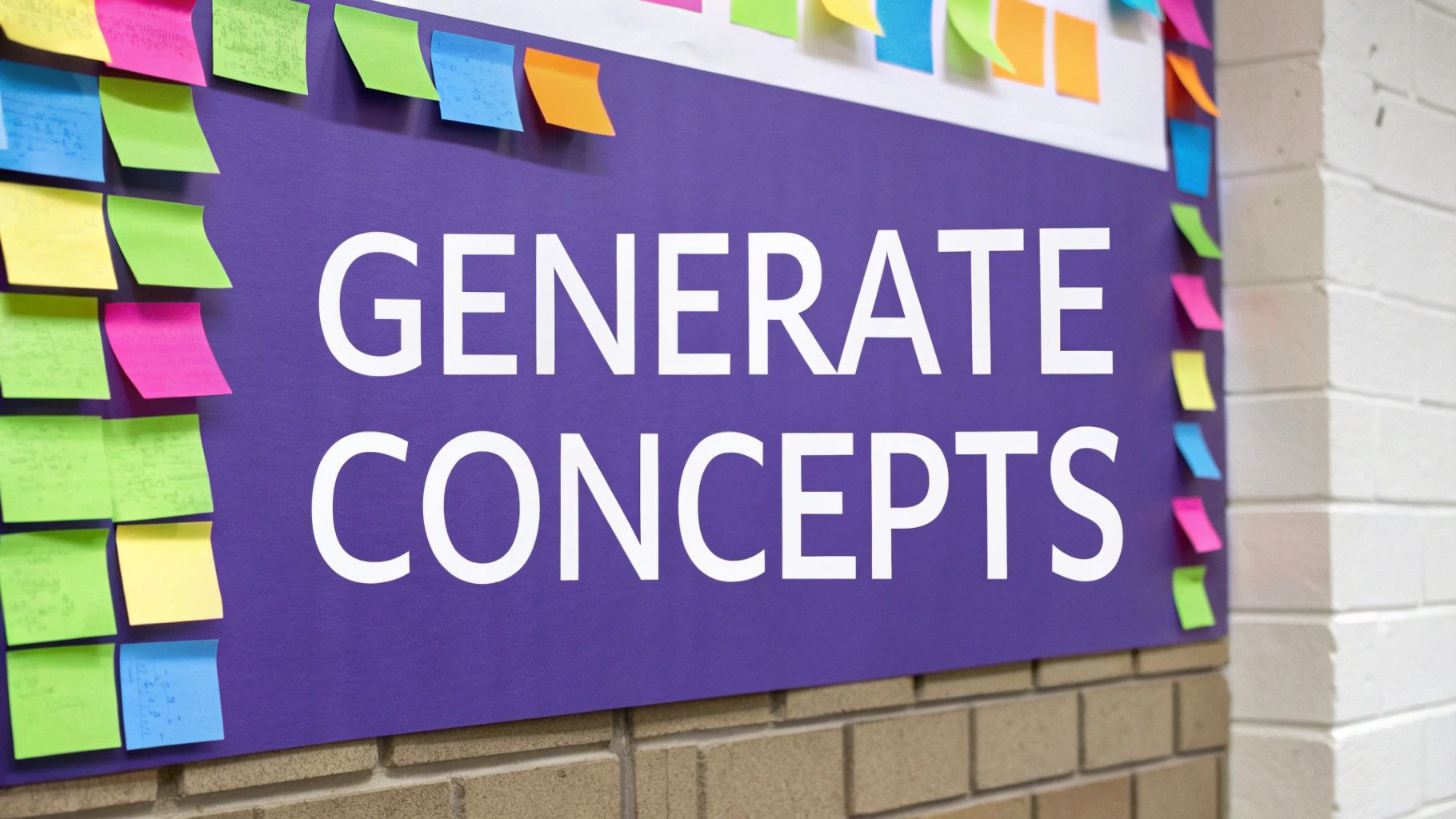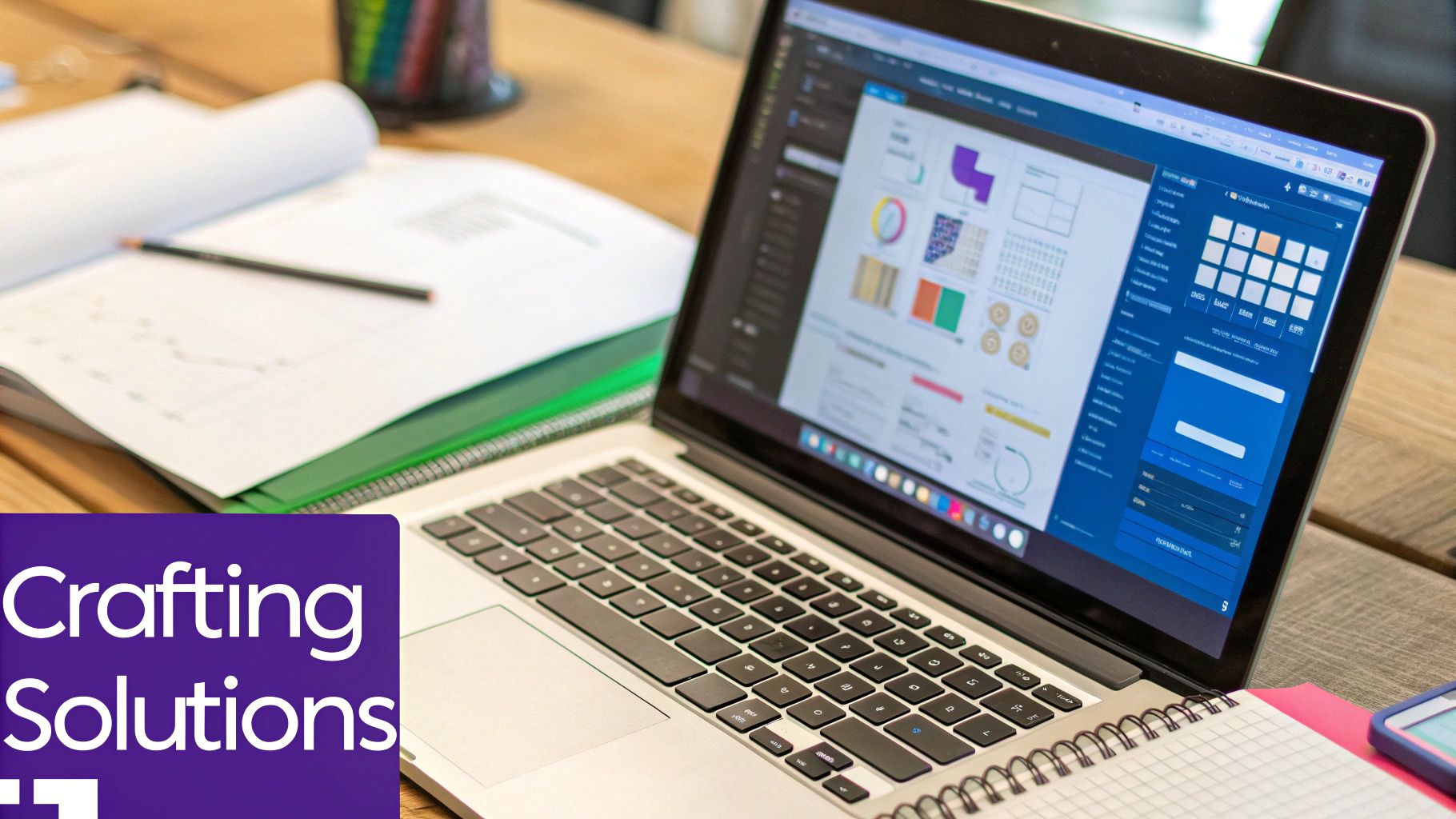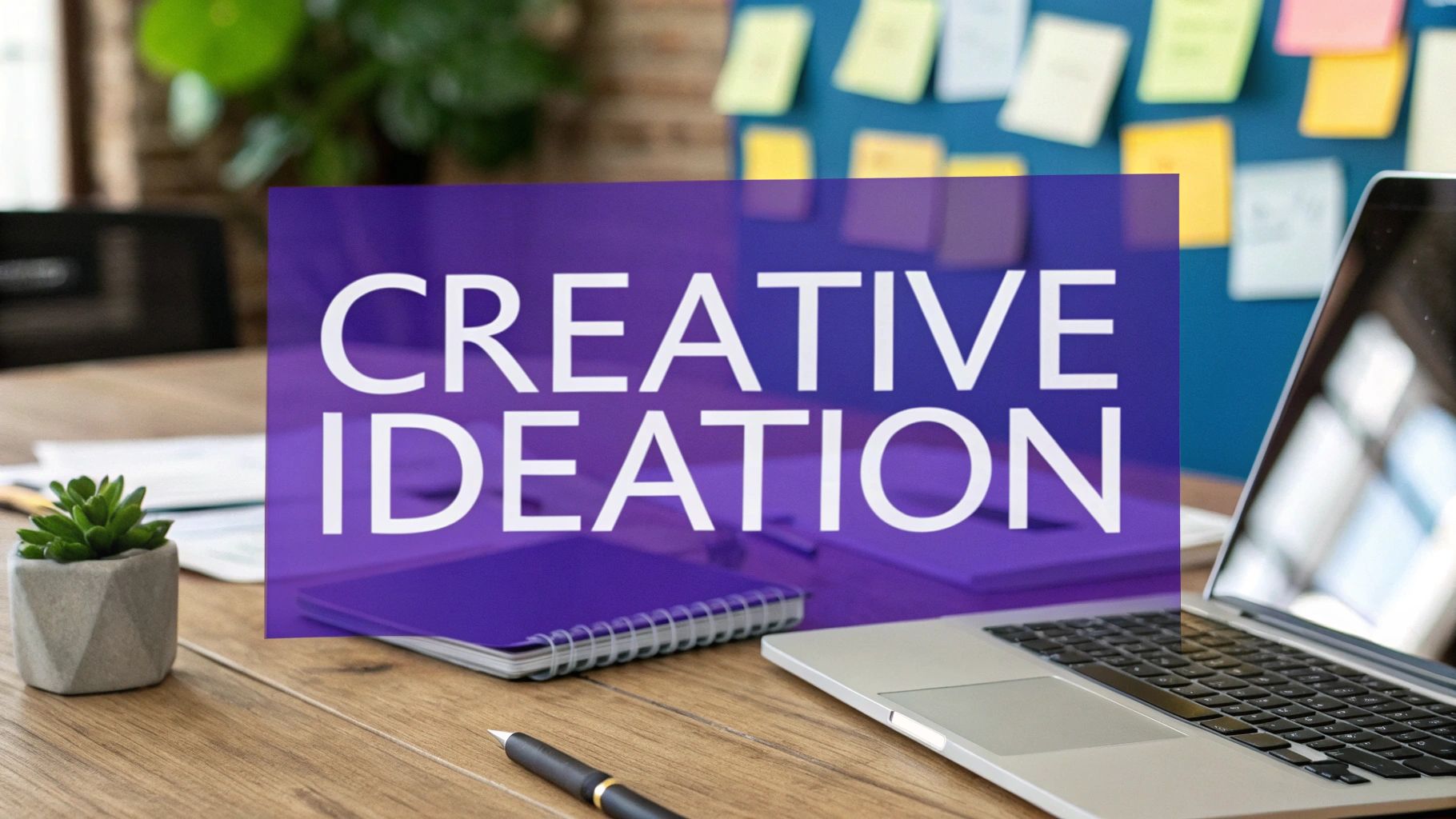Understanding The True Power of Ideation

Ideation is much more than just brainstorming – it's a complete system for creating and developing new ideas. When done right, it helps teams solve problems and create meaningful solutions. Understanding how ideation works is key for anyone looking to build something new.
The real strength of ideation comes from its structured approach. While casual brainstorming can be helpful, proper ideation follows specific steps to get the best results and avoid common problems like getting stuck in unproductive discussions. This structured method has deep historical roots. In 1953, business leader Alex F. Osborn introduced formal brainstorming techniques in his book Applied Imagination. His advertising agency BBDO went on to become the second agency in the US to reach $100 million in billings by 1951, powered in part by these methods. Learn more about the origins of brainstorming.
The Importance of Strategic Ideation
Strategic ideation connects creative thinking directly to business goals. By focusing idea generation on specific objectives – whether developing products, improving services, or tackling business challenges – teams can make sure their creative efforts drive real results.
Key Benefits of Effective Ideation
Good ideation practices provide clear advantages:
- More New Ideas: Creating an environment that welcomes creative thinking leads to fresh solutions
- Better Problem-Solving: The ideation process gives teams tools to break down and solve complex issues
- Stronger Teamwork: Group ideation sessions bring different viewpoints together
- Quick Decisions: Having a clear process helps teams evaluate ideas and move forward faster
These benefits show why ideation matters for success. When teams learn to use ideation methods well, they can do more than just come up with ideas – they can create real innovations that make a difference.
From Ideas to Innovation: A Modern Guide to Design Thinking

Top companies like Google and Apple use targeted ideation as part of their design process. This goes beyond just brainstorming – it's about creating new solutions and opportunities within a clear structure. Their success shows how effective ideation can drive real business growth and product innovation.
Making Ideation Work in Design Thinking
Good ideation pushes design thinking to new levels. While basic design thinking helps solve problems, adding focused ideation methods opens up many more possibilities. Teams can move past small improvements to find breakthrough solutions. Companies that master this approach stay ahead of market changes instead of just reacting to them.
The roots of design thinking trace back to the 1960s and 70s, with important work by cognitive scientist Herbert A. Simon. In his 1969 book The Sciences of the Artificial, Simon described design as a way of thinking and highlighted quick prototyping and testing. Learn more about the history of design thinking. This background shows why having a clear process matters for solving problems.
Key Tools and Methods
Successful teams use several proven approaches to get the most from ideation sessions:
- SCAMPER: This method helps teams look at existing products in new ways through specific prompts about substituting, combining, adapting, modifying, finding new uses, eliminating, and reversing.
- Design Sprints: These focused workshops help teams quickly create and test solutions to specific challenges in a short timeframe.
- Brainstorming: When done with clear goals and guidelines, group brainstorming remains one of the best ways to generate many ideas quickly. Remote teams can use tools like Bulby to make these sessions work well online.
Using these structured methods helps ensure ideation leads to real results, not just random ideas. Teams can bridge the gap between concepts and practical solutions by adapting these approaches to fit their specific needs. This creates a foundation for effective group ideation and problem-solving.
Mastering Collaborative Ideation Excellence

The best ideas often come from bringing different perspectives together. Smart companies know that effective ideation means going beyond internal brainstorming to tap into insights from customers, partners, and industry experts.
Expanding Ideas Through External Input
Good ideas can come from anywhere. While internal teams know their company and products well, outside perspectives often spot opportunities others miss. Customer feedback is especially valuable – it helps create products people actually want to use. Working with industry experts and partners can spark unexpected connections that lead to breakthroughs. Learn more about involving customers in ideation at Vanilla Forums.
Frameworks for Better Group Brainstorming
Having a clear structure helps groups brainstorm more effectively. The right framework ensures everyone can contribute their ideas and builds on others' thoughts productively. Let's look at practical ways to make these sessions work.
Creating an Environment Where Everyone Contributes
Running good brainstorming sessions means making sure everyone feels comfortable sharing ideas. Simple techniques like:
- Traditional brainstorming
- Brainwriting (writing ideas silently)
- "Worst possible idea" exercises
These methods help get people engaged. For remote teams, tools like Bulby provide helpful structure and guidance to keep online sessions focused and productive.
Moving from Ideas to Action
The real test comes after generating ideas. Success means:
- Picking the most promising ideas based on impact and feasibility
- Creating clear plans to implement them
- Assigning owners to drive them forward
This structured approach helps turn creative sessions into real results that improve your business. The key is maintaining momentum from ideation through execution.
Battle-Tested Techniques for Breakthrough Ideation
Every successful organization relies on proven methods for consistently creating great ideas. When used strategically, ideation leads to innovative solutions that help businesses grow. Let's explore some powerful techniques and practices.
Choosing the Right Ideation Methods
Selecting the most effective ideation approach depends on your goals and the specific problem you want to solve. Here are some proven methods:
-
SCAMPER: This method helps examine existing products or services through different lenses. It prompts questions about Substituting, Combining, Adapting, Modifying, Putting to other uses, Eliminating, and Reversing. A classic example is how the simple wheel evolved into countless applications across vehicles, toys, and machinery.
-
Design Sprints: These focused workshops bring teams together to quickly develop and test ideas. By setting a clear timeframe and bringing in different perspectives, Design Sprints help create working prototypes efficiently.
-
Brainstorming: When done right, traditional brainstorming remains effective for generating many ideas quickly. Clear goals and ground rules are essential. Tools like Bulby can make remote brainstorming more productive by keeping everyone engaged.
-
Brainwriting: This method asks people to write down ideas individually before group discussion. It works especially well for introverted team members or when some participants might dominate verbal discussions.
-
"Worst Possible Idea" Exercise: Teams purposely generate terrible solutions, which often reveals hidden assumptions and unexpected paths forward. This approach adds fun while challenging conventional thinking.
Making Ideation Sessions More Effective
Good facilitation makes a huge difference in getting results from ideation. Here's how to lead successful sessions:
-
Set Clear Goals: Begin with a specific problem statement so everyone focuses on the same target. This prevents discussions from going off track.
-
Mix Up Activities: Combine different methods to keep energy high. Switch between individual work, small groups, and full team discussions to engage different thinking styles.
-
Use Visual Tools: Whiteboards, sticky notes, or digital tools help capture and organize ideas. Visual elements make it easier to spot connections between concepts.
-
Watch the Clock: Set time limits for each activity and stick to them. Short, focused work periods often produce better results than long, unfocused discussions.
-
Stay Neutral: The facilitator should guide without judging. Make sure everyone gets to contribute and keep conversations on topic.
When organizations combine these methods with skilled facilitation, they create reliable ways to generate breakthrough ideas. The real power of ideation comes from unlocking creativity that leads to practical solutions.
Measuring and Maximizing Ideation Impact

For business ideas to create real value, they need to drive clear results. This means moving beyond random brainstorming to develop a systematic approach that reliably produces winning concepts. The key is tracking what works and constantly refining the process.
Setting Clear Success Metrics
Like any key business activity, idea generation needs specific metrics to gauge performance. Simple idea counts don't tell the full story – we need ways to evaluate quality and impact.
Important metrics to track include:
- Quality Score: Rate ideas based on creativity, practicality, and potential business value
- Action Rate: Track what percentage of ideas move forward to implementation
- Business Results: Measure how implemented ideas affect key goals like revenue and customer satisfaction
By consistently measuring these factors, teams can understand which approaches deliver the best ideas. This allows data-based decisions about improving ideation methods.
Using Evaluation Tools
Several proven frameworks help assess idea potential. One effective model examines ideas through three lenses: customer desire (do people want this?), technical feasibility (can we build it?), and business fit (does it work with our strategy?). This ensures ideas meet market needs, can be executed, and support company goals. Structured brainstorming tools, like those from Bulby, also help organize and evaluate ideas systematically during creation.
Creating Learning Loops
Successful companies don't just measure ideation – they use those insights to keep getting better. This means regularly reviewing data, spotting areas to improve, and adjusting approaches based on what's learned. For example, if few ideas get implemented, teams might focus on making idea selection more effective. Teams using remote tools like Bulby can track ideas from start to finish, creating natural feedback cycles. These learning loops help organizations consistently create valuable ideas that meet evolving business needs.
Building an Innovation-Driven Organization Through Ideation
Creating a truly innovative organization means making ideation part of everyday work life, not just having occasional brainstorming sessions. The most effective companies build environments where new ideas flow naturally and get the support needed to grow into real solutions. Let's explore how successful organizations create and maintain these idea-friendly cultures.
Overcoming Implementation Challenges
When making ideation part of company culture, two key obstacles often emerge. First, employees may resist changing established routines and view ideation activities as extra work. Clear communication about how new ideas improve processes and drive growth helps overcome this resistance. Second, fear of failure can stop people from sharing creative thoughts. Building a culture that treats failures as valuable learning experiences helps teams innovate more freely.
Developing Strong Ideation Systems
Good ideation needs structure to thrive. This means creating clear paths for generating, evaluating and implementing ideas. For example, teams can run focused "idea sprints" using methods like brainwriting to spark different thinking approaches. Remote teams can use tools like Bulby to guide exercises and work together effectively. Setting aside dedicated time for ideation ensures it remains a priority alongside daily tasks.
Keeping the Energy Going
New programs often start with high energy that fades over time. To maintain momentum, regularly highlight both major and minor wins that come from ideation work. Share success stories about projects that began as brainstorming ideas. Recognize team members who consistently contribute valuable suggestions. Keep refining your ideation methods based on what works best for your teams. Just as products evolve, idea generation approaches should adapt and improve.
Practical Ways to Boost Creativity
Key steps for creating an idea-friendly environment:
- Training: Give employees specific techniques for generating and developing effective ideas
- Workflows: Create clear processes with defined guidelines and timelines
- Environment: Build trust so people feel safe sharing early-stage ideas without judgment
Following these strategies helps organizations develop reliable idea pipelines that drive continuous improvement and growth.
Want to energize your remote team's creative thinking? Try structured ideation with Bulby today!

